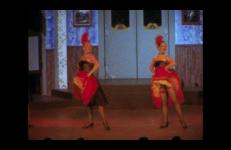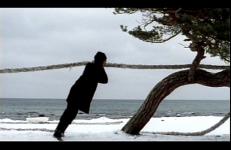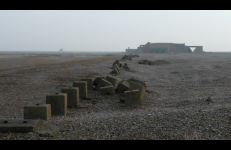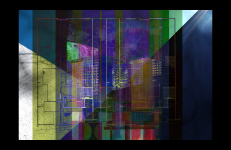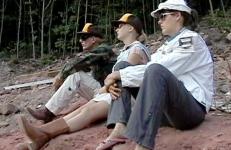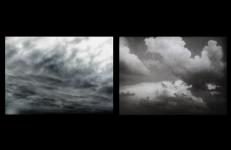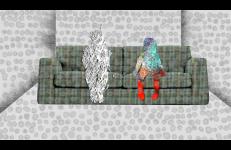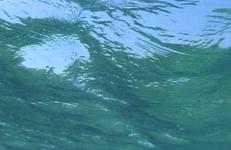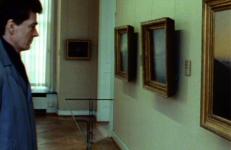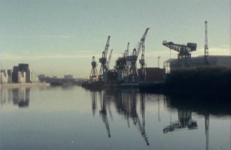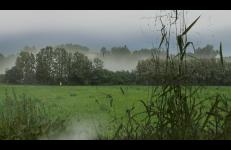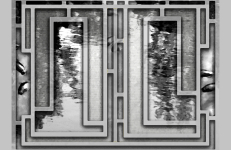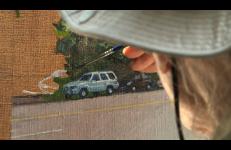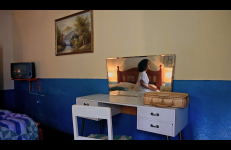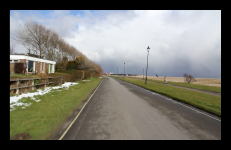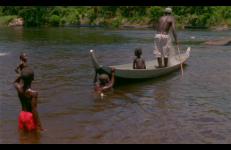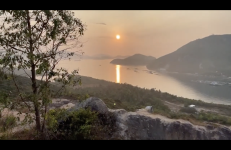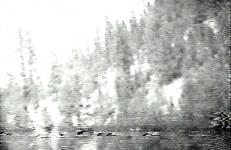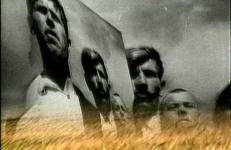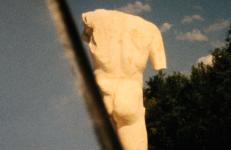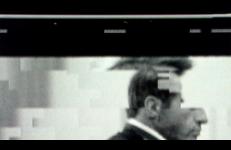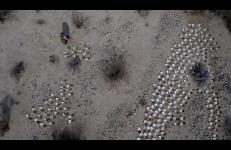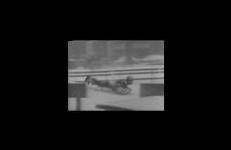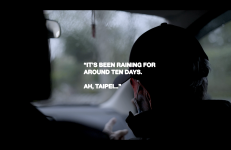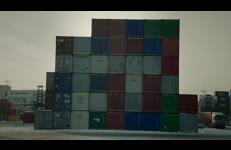The urge to relieve a winter valley of permanent shadow and find fortune in alluvial gravel are part of a long history of desire and extraction in the far Canadian north. Cancan dancers, curlers, ore smelters, former city officials and a curious cliff-side mirrored disc congregate to form a town portrait. Shot on location in Dawson City, Yukon Territory.
Landscape
Outwardly from Earth's Center is a fictitious narrative about a society on an unstable piece of land that is in danger of disappearance. The situation requires the population's collective initiative in order to secure individual survival and to allow the society to remain. The concept's background is somewhat realistic since Sandön moves approximately one meter per year.
Over The Horizon is a moving image installation that takes its name from the failed radar system developed on Orford Ness in Suffolk during the Cold War. The building that housed it and its aerial field are now used to broadcast the BBC World Service to Europe. Over The Horizon revisits the site where my earlier film Cobra Mist was made and explores through photography and sound the memory of a place, the remnants of history and evidence of stories true or rumoured.
The Palace at 4 am is the experience of a fragile palace of collisions suspended in a montage vision. A hazy patchwork of structures. The Palace becomes visible only to repeatedly collapse in a liminal interference of the absence. An unrest landscape of the insight. Space-time of thresholds. This is The Palace at 4 am.
Through a successful eBay bid in January of 2004, 1975 eteam dollars turned into 10 acres of personal U.S. property. The lot, a generic square within the larger American grid of townships, is located in the desert of Nevada. The closest settlement, Montello, "The town that refuses to die", is eight miles away, and the almost abandoned airbase Wendover, at the edge of the Salt Flats, is located about 30 miles SE. It's the 10-acre lot and its surroundings that started the eteam's search for solutions to problems, which were created by big systems that had made some small mistakes.
The four‐part cycle Parallel deals with the image genre of computer animation. The series focuses on the construction, visual landscape and inherent rules of computer-animated worlds.
“Computer animations are currently becoming a general model, surpassing film. In films, there is the wind that blows and the wind that is produced by a wind machine. Computer images do not have two kinds of wind.”
-- Harun Farocki
Paternal Rites is a first-person essay film that examines the secret underbelly of a contemporary Jewish American family as they grapple with the aftereffects of physical and sexual abuse on their present-day lives. It is also a groundbreaking film about the nature of trauma and memory itself: the ways in which trauma encrypts in uncanny ways; the function of speech and narrative in the process of decryption; and the role of film and filmmaking in the practice of healing.
Path combines striking imagery of the earth’s topography from the air, the ground, and beneath the sea. With calming shots of living ocean coral and acrobatic aerial footage of the Illinois prairie, Path investigates the physical sensations of the body as it moves through time and space, closely observing the natural world.
"Persistence was shot in 1991-92 in Berlin, and edited with films by U.S. Signal Corps cameramen in 1945-46, obtained from Department of Defense archives. Interspersed through these materials are filmic quotations from Rossellini's Germany Year Zero (1946). A meditation on the time just after a great historical event, about what is common to moments such as these—the continuous and discontinuous threads of history—and our attachment to cinematic modes of observation that, by necessity, shape our view of events.
Petrolia takes its name from a redundant oil-drilling platform set in the Cromarty Firth, Scotland. The film looks at the architecture of the oil industry along the Scottish coastline where oil and gas supplies are predicted to run dry in the next forty years.
A man with two dogs crosses a landscape. A person walks along a ridge and stops to look at the skyline. Other people run while nature shrinks back to its enigmaticness. In this video landscape doesn’t evolve according to simple time curves, but according to the particular mode of crossing of a weather element: fog.
Both Vermont Landscape and Pond Life followed two opera collaborations with composer Steve Reich. The operas were a new genre called a Theater of Ideas, which said a great deal about the world cultures in which we all live. In contrast, these two small works are quiet, with no words.
Since the early 1970s, Rackstraw Downes has committed himself to painting from observation, on site, from start to finish. He has painted both urban and rural landscapes, as well as interior spaces, in New York, Texas, and Maine. Although he paints exactly what he sees, through his labor ordinary sites become transformed into extraordinary scenes.
A woman stands on top of a hill in Namibe desert in Angola, looking into an extensive horizon of a vast desert, she signals the hope of crossing these borders symbolizing the repossession of the land and the regaining of a lost identity. The landscape as pathology is explored through these images; how past violence manifests in the landscape of the present, both intrinsically and symbolically. We live in a present space, but one that bears the marks of its history. As much as we occupy places, they have the capacity to pre-occupy us.
Rising 5th (Re-staging of a test for an unrealised memorial to Benjamin Britten) is a video work and sound installation that re-stages the story of the architect H. T. ‘Jim’ Cadbury-Brown’s unrealised memorial to Benjamin Britten. The memorial was to be a huge hulk of wood standing on Aldeburgh beach with two holes in the top designed to sound two signature notes from Britten’s opera, Peter Grimes, when the wind blew fiercely.
“Animists are people who recognise that the world is full of persons, some of whom are human, and that life is always lived in relationship with others.”
-- Graham Harvey, Animism
Trance dance and water implosion, a kino-line drawn between secular freak-outs and religious phenomena. Filmed in a single take at a sacred site on the Upper Suriname River, the minor secrets of a Saramaccan animist's everyday are revealed as time itself is undone. Rites are the new Trypps -- embodiment is our eternal everything.
A weeklong, episodic live-streamed landscape film that attempts to reimagine the genre of a road movie in Hong Kong. Each of the seven short films begin at exactly at the moment of the official sunrise in Hong Kong. Inspired by a series of personal correspondence from 2016 and a lecture by Hong Kong film critic and programmer Clarence Tsui at Hong Kong Baptist University, A Road Movie Is Impossible in Hong Kong takes up the provocation that a road movie is impossible in Hong Kong.
Originally part of a larger sculptural installation using prospector's tools, this tape reenacts the search for "Olga," a miner's wife who disappeared on her honeymoon in 1936. As Paul and Marlene Kos call out, "Olga... Olga...", the camera scans the Wyoming wilderness, and their search becomes ritualistic, the repetitive calls building in intensity and breaking down into chanted moans.
A self-described “collage piece” of “stolen images,” Shanghaied Text starts with quiet Montana landscapes, among which are views of a powerful dam. When the dam breaks loose you find yourself “shanghaied” to places unknown, where Kobland confronts you with a provocative mix of historical, lyrical, sexual and political references. Using quotes and pieces from movies by Vertov, Dovjenko, and Buñuel, along with archival images of social protests from the liberation of Paris, the piece builds to an operatic culmination with Turandot’s final choir.
The ground holds accounts of once pagan, then christian and now muslim ruins of the city built for Aphrodite. As she takes revenge on Narcissus, mirrors reveal what is seen and surfaces, limbs dismantle and marble turns flesh.
An homage to Chicago's East 95th Street Bridge, Calumet Fisheries and to a couple of the city's infamous brothers. The take-out shack, originally glimpsed in the background of a scene from The Blues Brothers, still operates. It has become a real-world portal to a cinematic past. Propped along the edge of the 95th street drawbridge, the building is framed by the towering infrastructures of the Chicago Skyway and Calumet Harbor.
The Sky Is Falling... is part of an ongoing series of performances that make up The Data Humanization Project.
On a snow-covered New Year's Day in New York City, Snow (I Wish There Was Cars) captures a city at a standstill: children sled, wind whips snow over empty streets, and New Yorkers search for warmth in a deserted urban landscape.
Shot by Parry Teasdale in 1971, with music also by Teasdale.
Directed by artist and filmmaker Tiffany Sia, The Sojourn imagines a restless landscape film in Taiwan. Visiting scenic locations shot by King Hu, the short experiments with the road movie genre and its intersection with the martial arts epic. Sia meets actor Shih Chun, who played the protagonist in Hu’s Dragon Inn, Touch of Zen and other wuxia films, as he guides the quest to re-encounter the iconic landscapes where Dragon Inn was shot. He counsels on the perfect conditions of mist and weather.
Rosa Barba produced a science fiction film based on interviews with local residents and individuals involved in the land suppletion project for Maasvlakte 2. Barba asked the interviewees to imagine what this new land could look like in the future. While we see images of the new land, the slufter: a storage reservoir for heavily contaminated sludge from the new Meuse river, the construction of the huge docksides, basalt blocks, empty containers and the mechanical movements of the transhipment process, we listen to a story apparently taking place in the future.




